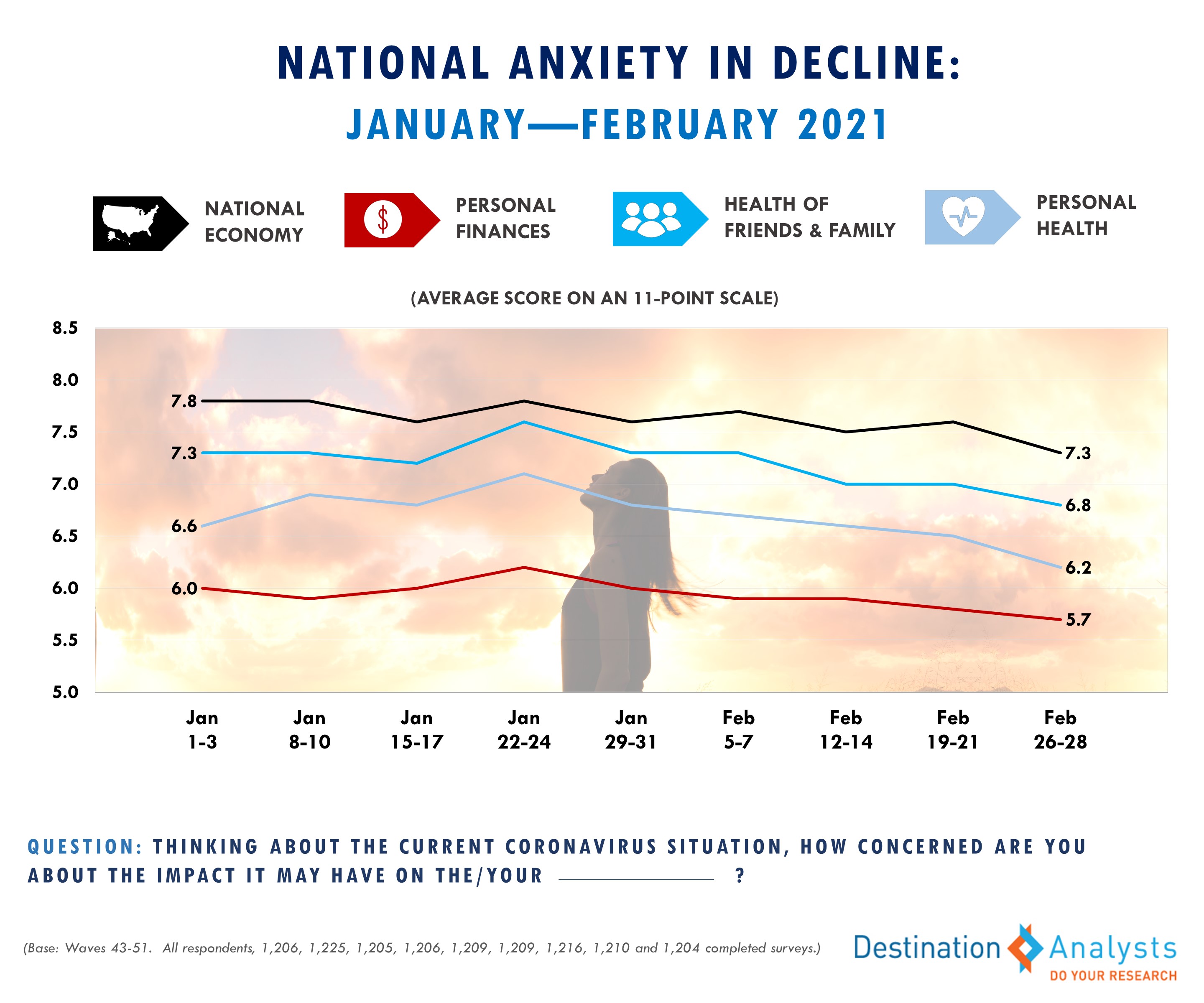Americans’ positivity towards travel reached more pandemic-era peaks as travel plans for even the next few months slowly but surely grow. In a sign of confidence about travel’s safety, Americans traveling for Spring Break look to be prioritizing new destinations for these trips. Most Americans, however, believe mask-wearing will be with us for several months.

IMPORTANT: These findings are brought to you from our independent research, which is not sponsored, conducted or influenced by any advertising or marketing agency. Every week since March 15th, Destination Analysts has surveyed 1,200+ American travelers about their thoughts, feelings, perceptions and behaviors surrounding travel in the wake of the coronavirus pandemic, and explored a variety of topics. The findings presented below represent data collected February 26th-28th.
Key Findings to Know:
It appears Americans believe that the light at the end of the tunnel is getting close. COVID-19 anxiety is at a low, with notable declines in their concerns about contracting the virus and the financial impact of the pandemic. Meanwhile, optimism about the course the coronavirus situation will take in the next month reached another record high, with 49.1% feeling things will get better and just 13.7% feeling it will get worse. This is a marked change from the start of the year, when 55.9% of Americans were pessimistic and only 20.9% were hopeful about the coming weeks.
Americans are feeling safer both at home—48.2% are comfortable going out for leisure in their own communities, nearing where we were March 15th, 2020—and with travel. The average rating of the more than two dozen travel activities we track as unsafe reached another pandemic record low, at 43.2%. Less than half of American travelers are feeling flying on airplanes, dining in restaurants, visiting museums and attractions, shopping and staying in hotels and other lodging are unsafe. Although a majority still feel unsafe with international travel and conventions/large group meetings, the proportions avoiding conventions (58.5%) and international travel (67.1%) are at record lows. Nearly two-thirds feel at least somewhat confident they can travel safely right now, and travel guilt fell to 39.9%. Americans remain highly open to travel inspiration and another pandemic record 63.9% are in a travel readiness state-of-mind.
Looking at the COVID vaccine’s role in travel sentiment, a majority of Americans continue to say that the vaccines make them optimistic about traveling safely and life returning to normal in the next 6 months. 63.3% of American travelers have themselves or know someone who has already received a vaccine. In fact, over one-third of Baby Boomer travelers report they have already received their COVID-19 vaccine. Now a record 36.9% of American travelers—including 41.6% of Millennial age travelers—have made travel plans specifically in anticipation of more widespread vaccination.
Trips and travel plans keep growing. Over 60% of American travelers did some kind of travel dreaming and/or planning in the last week alone, including 15.1% who made travel reservations. A growing percentage of American travelers say they will be taking at least one leisure trip in the next three months—now at 54.6%. More than 84% already have tentative trip plans for the remainder of 2021, with June through October the peak months for trips. While many trips will remain regional for the short-term, a quarter of American travelers will take their next commercial air trip by June. Escaping stress and spending time with family remain the primary motivators for travel.
Lodging preferences for travel over the next three months appear to have shifted from the early pandemic period. When asked to imagine that they were traveling at some point in the next few months and if they would generally prefer to stay in a hotel or a home rental through a service like Airbnb, 48.1% had stronger preference for hotel—up from 41.3% in March 2020—while 19.8% showed a strong preference for home rental—down from 30.3% last March.
With travel plans slowly but surely growing in the next few months, we looked at the outlook for the Spring Break period. This week, 12.4% of American travelers said they have a Spring Break trip planned. Interestingly, over two-thirds of these travelers say it’s important to them that they experience a new destination for this trip. Half of these Spring Break period travelers plan to use an airplane for their trip and head more than 500 miles away from home. Beach destinations are, of course, popular, as are National Parks and rural areas. Luxury hotels appear to be the most common lodging option for these Spring Break travelers.
Looking towards the conclusion of the COVID-19 pandemic, 71.3% of American travelers will continue to wear masks after they are fully vaccinated. Indeed, nearly half expect it will be 2022 before people will be able to safely stop wearing masks in public. When asked to imagine how they would feel on their first post-vaccine trip if the place/destination/attraction they were visiting still required masking, 65.0% said they would feel “fine,” if not “great.”





































